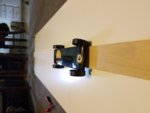We finished this year's car a week early out of necessity since I'm traveling for business this week Sadly, I won't be back in time for the race, so my son will have to prep and check-in without me looking over his shoulder. Still, he asked me to walk him through the whole procedure and took notes 

(Last year he dropped the car before the race and took 2nd place...)
Anyway, we went a little thinner this year, about 1/2" in the back (compared to 3/4" last year. (We used 3/8" tungsten cylinders, 2 oz worth behind the axle and 2 oz worth in front of the axle in laterally drilled holes. COM at about 0.7". Used Microbrush's Clear Jig to drill the rears at 3 degrees, did a straight drill on the FDW and raised the NDFW. I built a concentricity gauge for the wheels this year and taught my son how to use it. He sorted through our collection of wheels and found 3 that were between .001 and .002 runout. They were all mold 11, oddly enough. We polished the bores with Novus 2 and burnished with pinewood pro graphite.
We sorted through axles to find the straightest ones we could, then went with modern thinking by not filing off the crimp marks on the shaft, just the burrs under the head. 1000-3000 grit on the head, 2000-3000 grit on the shaft over the crimps, followed by Brasso on a piece of leather and a spritz of pledge.
We bent the FDW's axle using the old bending tool that you hit with a hammer, but with a few strips of business cards to give us as much bend as possible while still fitting through the hub without any force.
Installed with 0.030" gap in the rear, 0.020" gap on the FDW. Graphite applied liberally and spun for a few minutes. Wheels felt smooth as butter with no wobble or chatter.
We checked the alignment prior to cutting the body with pin gauges and wheels and found it to be dead on.
However installing the rear axles with the widest part facing down (on the crimps) we found inconsistent results with the wheels not always migrating outward. So we rotated them 90 degrees to move the crimps fore and aft with the smooth part of the axle down and saw the issue correct immediately.
We tuned for 2.5" of steer in 3 feet. The severe bend made tuning a little frustrating, but a fun experience.
Now we wait. And I'll be on a plane over the Atlantic while the race is happening and won't find out how it went until I land, or possibly until I get home if my family decides to keep me in suspense. But whatever happens, it was a great time building with my Webelos Scout.


(Last year he dropped the car before the race and took 2nd place...)
Anyway, we went a little thinner this year, about 1/2" in the back (compared to 3/4" last year. (We used 3/8" tungsten cylinders, 2 oz worth behind the axle and 2 oz worth in front of the axle in laterally drilled holes. COM at about 0.7". Used Microbrush's Clear Jig to drill the rears at 3 degrees, did a straight drill on the FDW and raised the NDFW. I built a concentricity gauge for the wheels this year and taught my son how to use it. He sorted through our collection of wheels and found 3 that were between .001 and .002 runout. They were all mold 11, oddly enough. We polished the bores with Novus 2 and burnished with pinewood pro graphite.
We sorted through axles to find the straightest ones we could, then went with modern thinking by not filing off the crimp marks on the shaft, just the burrs under the head. 1000-3000 grit on the head, 2000-3000 grit on the shaft over the crimps, followed by Brasso on a piece of leather and a spritz of pledge.
We bent the FDW's axle using the old bending tool that you hit with a hammer, but with a few strips of business cards to give us as much bend as possible while still fitting through the hub without any force.
Installed with 0.030" gap in the rear, 0.020" gap on the FDW. Graphite applied liberally and spun for a few minutes. Wheels felt smooth as butter with no wobble or chatter.
We checked the alignment prior to cutting the body with pin gauges and wheels and found it to be dead on.
However installing the rear axles with the widest part facing down (on the crimps) we found inconsistent results with the wheels not always migrating outward. So we rotated them 90 degrees to move the crimps fore and aft with the smooth part of the axle down and saw the issue correct immediately.
We tuned for 2.5" of steer in 3 feet. The severe bend made tuning a little frustrating, but a fun experience.
Now we wait. And I'll be on a plane over the Atlantic while the race is happening and won't find out how it went until I land, or possibly until I get home if my family decides to keep me in suspense. But whatever happens, it was a great time building with my Webelos Scout.

